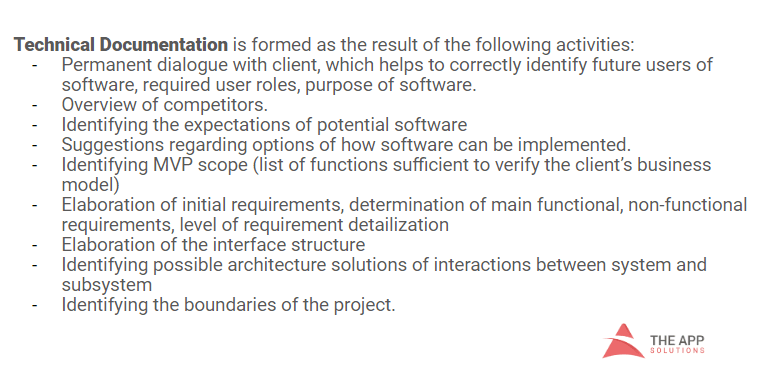REASONS WHY TECHNICAL SPECIFICATIONS ARE CRUCIAL FOR A PROJECTS’ SUCCESS
- What is technical specification documentation?
- How to write technical requirements
- Why Is It Important to Write Technical Documentation?
- Reasons to create a technical specification document
- Reason #1. Includes all technical details
- Reason #2 Provides flexibility for future changes
- Reason #3 Adds value to your app
- Reason #4 Helps to keep control of your product
- Reason #5 Allows reusing existing parts of the developed application
- Technical spec document: final thought
Technical documentation is essential for mobile and web project development. This document describes what an application consists of and its costs. Of course, it is possible to develop a mobile app without technical specifications and even a well-working one. However, it doesn’t guarantee that it will be an app that allows you to achieve specific business goals.
In this article, we share a detailed description of technical specifications and the primary reasons why you should have it for a mobile or a web project.
GETTING THINGS DONE: HOW TO HANDLE REMOTE PROJECTS
What is technical specification documentation?
In the technical specifications, you describe your future app in detail like a step-by-step recipe for a dish. We can define technical specifications as being like a cooking book where you write down what ingredients you’re going to use, the quantity, and in what order.

How to write technical requirements
Before writing technical specifications, you need to answer the following questions:
- Who is this app for? Whether it is for your current or future customers, your employees, or both.
- What tasks the application solves. If it is for customers, what will they be able to do with your app – order products, services, book, or stay updated about promotions? If it is for employees – how it can increase the efficiency of their work.
- On which devices can they use your application – smartphone, tablet, or desktop, and from which platform – iOS, Android, Windows.
- When do you want to get your mobile application finished? Here you’re setting the deadline – the date and time when a mobile app will be ready for usage.
- What is your budget? You should be aware of the amount of money to spend on an app and be prepared to invest it as you progress.
Once you’ve answered all of these questions for your technical requirements document, then it is time to move to the practical side and write technical documentation.
You, as a customer, can create this technical task by yourself in the following cases:
You’re working on a relatively simple project. If you need to create a non-dynamic mobile application, just a regular landing page with necessary information about a product/service. On the Internet, there are many templates on which you can write bullet points for your landing page technical design.
HOW TO HANDLE DEADLINES IN SOFTWARE DEVELOPMENT
You are an experienced developer and it is not a problem for you to prepare a technical description of your mobile app development.
In other cases, there is no better solution than creating technical specs with a team of other developers. Moreover, experienced IT developers have more in-depth knowledge of software development so that you will be safe from technical risks and bugs.
What solutions can we offer?
Find Out More
Why Is It Important to Write Technical Documentation?
Data provided by PMI’s Pulse of the Profession report says that around 47% of business projects fail because of poor technical documentation management.
Yes, the percentage is enormous, but we’ve shared it so you should learn from others’ mistakes to avoid failures in your project.
Technical documentation allows us to do the following:
- Structure the information and build a portrait of the application, define the goals and objectives of the project
- Analyze competitors and understand what functionality is needed in a new application
- Give developers a precise idea of a desirable mobile app and get a more accurate assessment
- Reduce costs through work automation, if this is an application for employee – interaction with customers, increase loyalty and sales – if this application is for customers

Reasons to create a technical specification document
Reason #1. Includes all technical details
Each missing detail increases project development time. It’s a proven fact that your technical document will help minimize the time for specialists to educate themselves about the app’s code, logics, interactions, and correlations inside of it. It’s a source of truth for your team.
Reason #2 Provides flexibility for future changes
Every feature documented means you’re able to introduce changes in both software and team without any hassle. You’re not worried about newcomers failing to understand the logic of the software, or it takes too much time (which you’re paying them for). It’ll also help reduce errors or misinterpretations. On top of that, any improvements to functionality will be implemented in next to no time.
Reason #3 Adds value to your app
The technical spec document explains everything starting from architecture and design to all procedures inside of the app, and increases its cost and reliability. Otherwise, the app becomes a maze for those who aren’t familiar with your project.
Reason #4 Helps to keep control of your product
A clear, technical specification doc will always mean you’re free to change developers at any stage of the project. Without this paper, you can find yourself dependent on the knowledge of your current contractor – whether they do their work competently or not.
Technical documentation allows you to understand what you’re paying for. You see the structure of the future product and can adjust it before the start of development.
Download Free E-book with DevOps Checklist
Download NowReason #5 Allows reusing existing parts of the developed application
This optimization trend in software development brings its fruit – more profitability, productivity, and product quality for the company. It’s not only about the code, but also about separate testing and entire project plans, requirements, and test data. Without a development diary, this can’t be accomplished.

Technical spec document: final thought
A clear and consistent technical specifications document ensures that the app works properly, and meets your expectations and business goals. Thus, technical specifications are a must for a business that wants to create a mobile app and continue potential, regular growth.
At The APP Solutions, we are ready to bring our expertise and wide range of experience to help you develop technical documentation that matches your business goals.
DEDICATED DEVELOPMENT TEAM MODEL ANALYZED
For our customers, we create technical documentation during the Discovery phase to be certain we are on the same page as our clients. Find out more about our project management approaches from the article How the APP Solutions work.
We are as interested in the success of your mobile app development as much as you.
We recommend you take the process of writing technical specification documents seriously and make it clear, concise, and detailed. The more detailed it is, the more thorough your mobile app will be.
